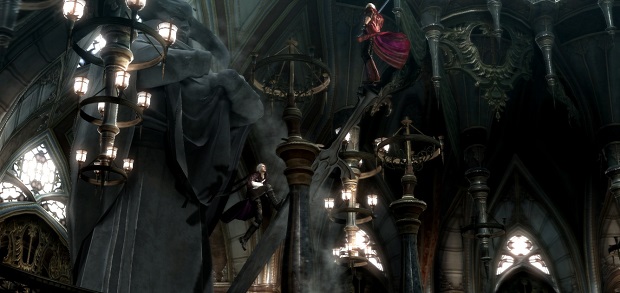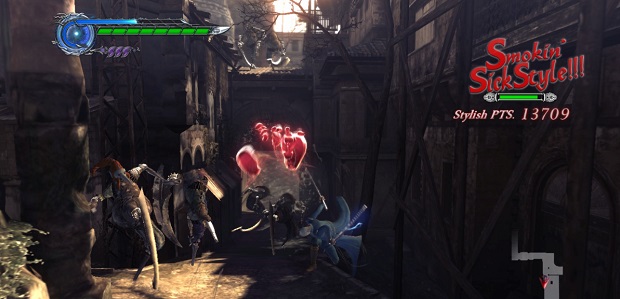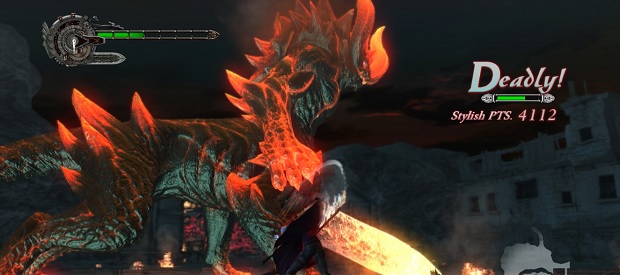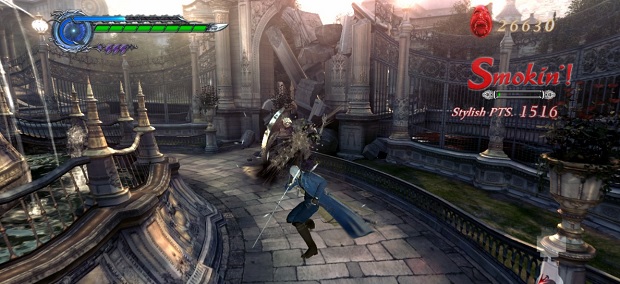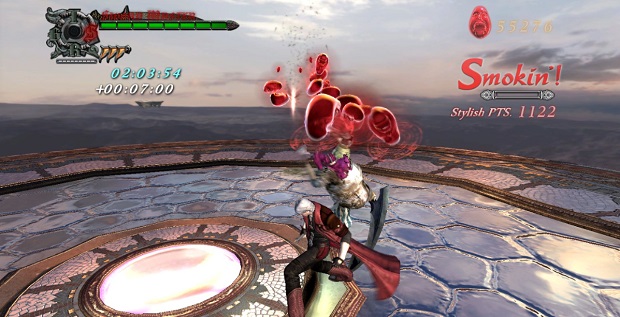Wot I Think: Devil May Cry 4 - Special Edition
Dante look good?
As the mighty PC strides into the future, a choice faces the great console developers. Support the biggest and most powerful platform on the planet or miss out on sales: seems like an easy decision, but the results can be questionable. When considering Capcom's Devil May Cry 4: Special Edition [official site], for example, exhibit A would be DMC4's original PC port in 2008, a straight-from-console affair that could only be controlled with a pad. Great game plus great hardware doesn't always equal great experience. So, with the Special Edition now launched, does this devil finally get his due?
DMC4: SE follows hot on the heels of Capcom re-releasing the first three DMC games as an 'HD collection' which was soon followed by a 'definitive edition' of Ninja Theory's DmC reboot. This is a comprehensive curation exercise, and clearly a new DMC of some kind lies in the near future, but it's worth asking why. Capcom like money for old rope, of course, although DMC4: SE is a more fully-featured project than the other re-releases. The fanbase may be niche but it's sizeable, with DMC4 selling over three million, and DMC's nature makes it much more replayable than the average action game.
Then you come to the reason that seems least prominent, but should maybe be at the top. DMC was created by Hideki Kamiya in the late 1990s, initially conceived as a more action-oriented Resident Evil spinoff – and with the idea for combo-based juggling taken from a glitch in another Capcom game, Onimusha: Warlords. DMC was released in 2001 and single-handedly established and invented the thirdperson hack-n-slash genre. Hideaki Itsuno is a big cheese at Capcom these days, best-known for Dragon's Dogma, but over the next seven years he would direct DMC2, 3, and finally 4.
The fact that Itsuno is directing DMC4: SE says something. Capcom may have its marketing and financial reasons for pushing definitive versions of the DMC games, but the company also has an unmistakeable pride in this series. And so it should. Very few genres are as purely system-oriented as the thirdperson fighting DMC pioneered, and to design a great close-combat system in three dimensions – which operates at breakneck speed – is simply beyond most developers.
I've written for RPS previously on how such systems operate and their effect on the player, so here it will suffice to say that a good fighting system is a near-unmatched engine of expression for players, stylish in everything, but with enormous depth and flexibility. Capcom's animation and programming teams are simply the best in the world at this, to the extent that the company's only real competitor is Platinum Games, founded by ex-Capcom employees.
DMC4's switch between Nero (whom you control for the campaign's first half) and Dante, DMC's traditional lead, is one of the game's best ideas: introducing a new character that feels familiar but with a fresh style and weaponset, allowing the player to get comfortable, and then blowing us away with the ultimate realisation of classic Dante.
Tiny changes can be enormous for a fighting system, and among DMC4's most important is that Dante's various fighting styles are selectable from the d-pad in realtime. These styles were introduced in DMC3: Dante's Awakening and each basically adds a new ability or series of moves that flow into and out of Dante's core skills. DMC4 allows access to four styles from the off and shortly unlocks the fifth 'Dark Slayer' style, adapted from DMC3's Vergil. Some like Sword Master are self-explanatory, adding new offensive capabilities and damage, while some like Trickster build huge scores from evasion and taunting, while the noble Royal Guard is based around gathering power from perfectly-timed parries – and unleashing it all in a boss-killing wave of energy.
Dante's moveset is already a flexible beast, both agile and crushingly powerful, but each of these avenues add something more. In DMC3 you mastered the styles one-by-one, with switching only possible between levels and at upgrade statues. In DMC4 everything Dante can do is at your fingertips, and the difference is everything. The nature of styles suits them to different situations, and in DMC4's crazier battles the make-up of what you're facing changes constantly.
This Dante is not just a supremely capable fighter, but perhaps the ultimate realisation of what DMC is about. This Dante can fillet anything in heaven or hell with precision, and make every hit along the way look fabulous. This Dante can skirt crowds with Trickmaster dodges, slam into them with a Sword Master's strikes, and flip back the scattered retaliation with some imperious Royal Guard. Not many individual characters are designed and re-designed by Capcom's finest over decades, but this Dante's fluid perfection is what you get when that happens.
DMC4: SE's greatest addition to the original game comes in the form of three new characters to play as. For a game like DMC4 this is a far more substantial thing than it may sound: thirdperson fighting games are built around the capabilities of the player's avatar, so a new character means a whole new way of playing.
Dante's brother Vergil returns from DMC3, and once more almost outshines his sibling. Vergil's moveset is built around three switchable weapons but everything pivots on the Yamato katana, a quicksilver blade that can slash crowds to ribbons and smash individuals with the force of a truck. A brilliant twist is the addition of a 'concentration' mechanic whereby minimising your actions increases Vergil's focus, so briefly standing still allows him to increase the power of certain moves and unlock others. Such a principle is the opposite of your usual DMC instincts amidst a crowd, but deliciously tempting and a fundamental inversion of Dante's style.
Trish and Lady are the other new characters and, while somewhat gimmicky, both showcase new ideas for fighting styles. Trish has access to all of her moves without weapon-switching, so she's a simpler character than the three mains, but makes up for this with a crowd-controlling sword fling that switches up her hand-to-hand moves, and the ability to trap airborne enemies in temporary lightning trails from her boots.
Trish shares with Lady a few more OTT pieces of hardware, but Lady is almost entirely an armament-focused character. She packs bazookes, berettas, grenades, harpoon guns, bayonets, and is basically about maintaining range and making everything blow up. This is certainly a new way to play DMC and with appropriate opposition it's not an easy one either. I doubt either will be replacing Dante in my heart, but the SE has to be praised for focusing on extras that feed into and show off new aspects of the original's system.
Sadly not everything is so rosy, and both the SE itself and the original game's design have low points. DMC4's non-combat sections have aged terribly, and weren't very good in the first place. The camera's too-frequent switches between free- and fixed-perspective is another big problem. This was perhaps intended as homage to the series' origins with fixed camera angles, but the effect is a disaster for players old and new, confusing navigation and adding real frustration to certain puzzle and platforming sections.
A good rule of thumb for DMC4's campaign is that if you're not fighting something, you're probably not having a very good time. It's that simple. The puzzles are never really mentally challenging, but involve hitting things or moving statues about or collecting an item. The platforming shouldn't be as awful as it is, because each character has a grapple-like move that zips them from point to point, but inexplicable camera changes mid-flight throw you off.
It should be emphasised that this is not how most time is spent in DMC4, but there's certainly more than there should be. The final twist of the knife, however, is that the game's structure is built around running through the first half, and then running back through those same environments in reverse with a different character. Capcom as a company has always tried to maximise the work it puts into assets, and DMC4's environments can be visually breathtaking, but this structure goes a little too far.
There's more. Though DMC4: SE comes with all the graphical options you'd expect the menu system is properly appalling, with needless trips back and forth through not-inconsiderable loading screens before you get into the action. It makes things like switching characters much more of a ballache than it should be, and forces you to return to the root title menu to quit the game. The port itself is clearly not lazy or rushed, so it's needlessly frustrating to find it presented within the menu framework of a 2008 console game.
And then there's the worst part. DMC4: SE is in large part a game made for existing fans, and yet locks many modes and costumes from the start – which can be unlocked by playing through various ways, or as 'DLC' micro-purchases. This absolutely stinks. To be fair to Capcom the decision to release at a mid-tier price (£19.99) was the right one, but it's also an unusual concession from this most dragon-like of Japanese mega-publishers. The price is right, but the gold has to be eked out somehow.
Whatever the reasoning such penny-pinching feels counter-productive. At a stroke it taints your goodwill as a player and as a DMC fan towards the whole project. This is a minor series of options removed in order to try and squeeze a bit more currency from the dedicated players, and Capcom knew exactly what it was doing. This game should feel like a celebration, not a shakedown.
So DMC4: SE has problems. But then it always has. Despite its commercial success DMC4 was the last DMC game Capcom made internally, before moving on to work with Ninja Theory on rebooting the series as DmC. At the time no-one realised this was a swansong.
When playing DMC4: SE you can see how certain parts of the design had grown archaic. How even Dante, as wonderfully flamboyant as ever, was skirting a razor's edge of self-parody. And how, perhaps, Capcom's DMC team felt they had reached their limits with the series. This Dante is the product of so many years of refinement that he feels complete. It makes this the kind of game where, despite all the little problems, mastering the core system is so rewarding they just stop mattering. And it's something of a full stop, for now at least, on one of Capcom's most original series.
This Dante's got it all, in other words. And where can you go after that?


